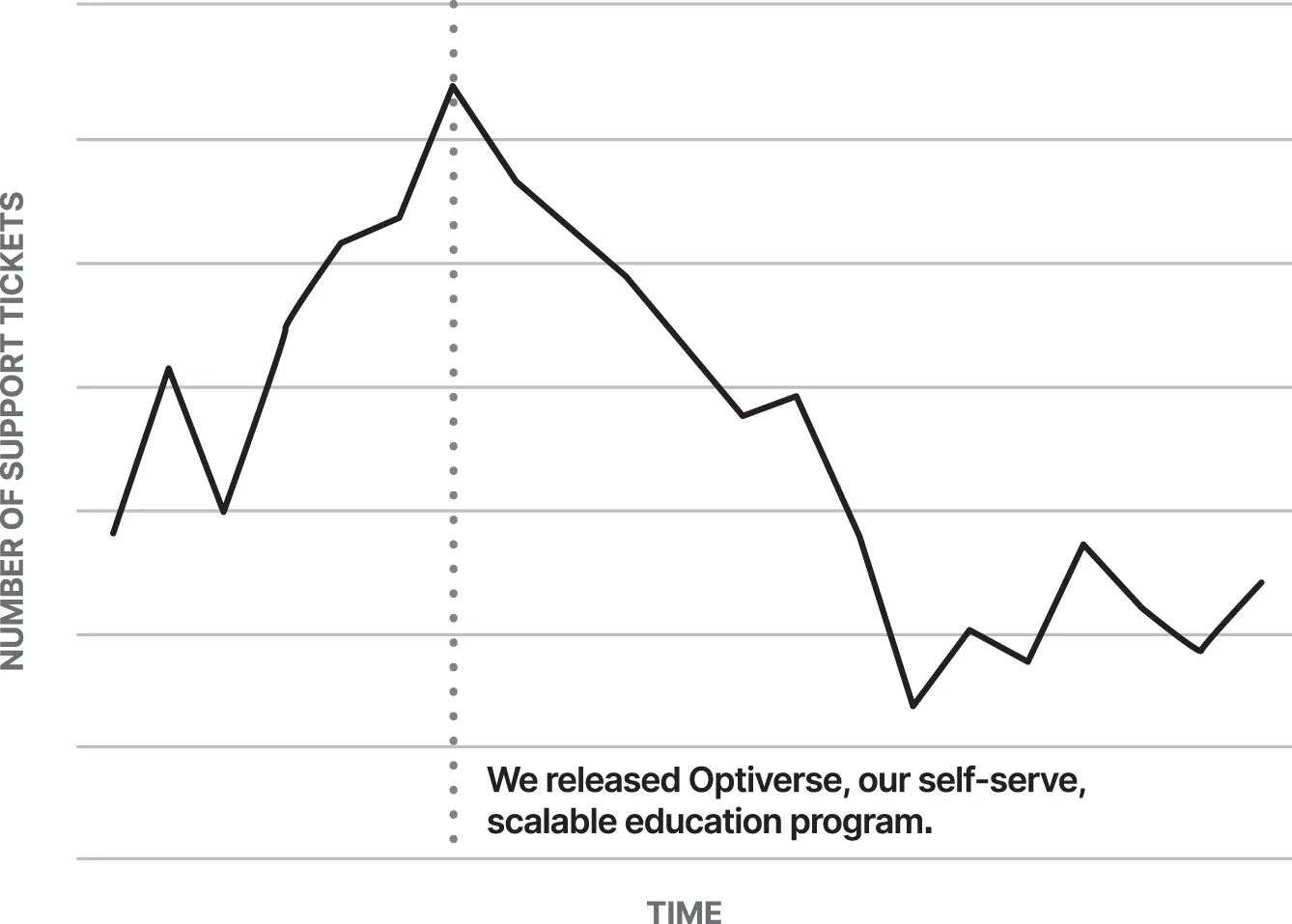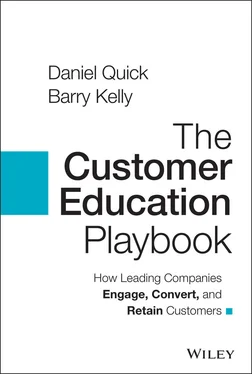Made to Measure: How to Prove ROI for Product Adoption
If you're a large enterprise, you may have the traffic and infrastructure available to you to distribute various types of content and test out different scenarios. For example, you might randomly distribute your customers into two groups and then run an experiment where one group watches a “Getting Started” video and the other does not. Then, you could track consumption rates and adoption rates over the first 30 days and get meaningful information on a causal relationship between your content and user behavior.
However, in the vast majority of cases, this probably isn't realistic. Instead, here are two other ways you can measure the success of your content on product adoption.
Trained/Not Trained Cohort AnalysisIn this analysis, you simply compare the behavior of two different groups: one trained, one not. First, you'll need to define trained . To do this, create content that users need to opt into, like video content that you have to register for and watch, a guidebook that needs to be downloaded, or anything else you can actually track. You'll then compare the people who interacted with the content (“trained”) to those who didn't (“not trained”) and measure product adoption rates between the two groups. Although this isn't a causal analysis, it'll still give you a great understanding of the relationship between consuming that content and product adoption rates.
Pre/Post Content Cohort AnalysisWith this approach, you push the customer education content to all of your customers by, for example, creating a three-minute video that new users watch the first time they sign into your product environment. You then track the data for product adoption after this content has been viewed, measuring the difference between the metrics you had before you launched the video. If you can get the support of your business leaders to push content to all of your users, this can be a great replacement for a true A/B experiment. While the pre/post analysis is also correlative and not causal, it more or less controls for confounding variables.
Goal 2: Scale Customer Support
Reducing the impact on the support team is a common business goal, and for good reason. As your company grows, it's natural that the number of tickets you get is going to scale with it, and no, unfortunately it doesn't matter how intuitive and easy your product is to use. What are you going to do to meet this need? Are you going to keep hiring more support agents, indefinitely? Obviously, that doesn't scale. Instead, you must figure out how you can deflect support tickets, and the best way to do that is through customer education.
Scaling your support offerings through customer education comes in the form of self-service resources. Whether that's help centers, online communities, or FAQs, self-service customer education can have a big impact on scaling your support team through documentation and resources.
Let's look in detail at one of these examples – online communities. These are often thought of as a means to build brand enthusiasm and customer advocacy. However, when done right, they can also play a huge role in ticket deflection. Customers can turn to the community with pressing questions, and an active community can often generate answers more quickly than a support team. On top of this, the best communities include experts with knowledge, experience, and best practices that can outweigh your in-house experience 10 to 1.
Of course, a successful community doesn't spring up overnight. You can't just build an online forum and expect it to succeed. This isn't Field of Dreams . Most communities suffer from the tumbleweed effect. The chemistry of a thriving online community takes a lot of work to spark it into lift and requires investment to nurture it from the ground up, from attracting new members to moderating conversations and helping it to scale and grow.
Stop Thinking about Self-Serve as a Compromise
Once upon a time, self-service meant doing something yourself to save on money or time, often at the expense of the experience. Think about it. A self-service café, even at its best, cannot match the experience delivered by a fine-dining restaurant. Mowing your own lawn might not get you those smooth lines, but hey – you've saved a few dollars in the process.
With the rise of digital experiences, however, this is no longer the case. Self-service is now synonymous with speed, agility, flexibility, and satisfaction. Customers don't have to sit on hold or wait for an agent to get back to them via email. When it comes to customer education, you can use self-service to empower your users to get more out of your product.
Of course, that doesn't mean your support reps can't get the ball rolling. With the right content and training in hand, support interactions can be transformed into learning experiences, and as your support agents continue fielding tickets, they can begin to create macros in response to the specific kinds of questions that they're being asked. The macros could include links to helpful resources, a recommendation for additional training content, or even the support agent themselves doing a quick tutorial on the spot. In this way, your customer education program begins to transform support interactions into learning experiences and even operationalizes them in the moment.
Made to Measure: How to Show the Success in Scaling Customer Support
Your main metric for this goal is ticket deflection rate. Your support tickets will naturally scale with the growth of your customer base. However, once you invest in self-service resources, you will see that trend reverse. With each additional month, more self-service resources become available, and more customers join your community to offer one another help and support. Customers will file fewer support tickets even as your company expands.
Figure 3.1shows how the customer education team at Optimizely presented the relationship between self-service and ticket deflection. The day we launched Optiverse (a self-service resource hub for Optimizely customers), support tickets plummeted, even while the number of customers continued to grow.
You can do this kind of visual representation for individual support ticket categories, too, and clearly illustrate how customer education can solve a specific issue. Look at the challenges that attract the greatest number of tickets in your organization and create targeted content that allows users to self-serve that problem. This could be anything from “How do I change my account info?” to “How do I turn off that cat filter on Zoom?” Present a time-based line graph that shows ticket requests for this issue over time, with a clear callout for when you launch the support materials.

Figure 3.1 Optimizely Support Ticket Deflection
Goal 3: Maximize Customer Success
Every time a new customer is onboarded to your product, your customer success managers (CSMs) have the same conversation. They may have these conversations dozens of times a week; they could probably recite them word-for-word in their sleep. Does this sound like your company? If so, then your CSMs are massively underleveraged. How can they offer deep strategic value if they're always dealing with basics?
Daniel on Customer Education as a Scale Engine
When I led customer education at Asana, I reported into customer success, and I was dismayed to learn on my first day that my director – who I liked and respected – was leaving. We took a walk and I asked him about his thoughts on the role of customer education. He explained that he had a lightbulb moment when he realized that he had been traditionally building customer success teams by starting with CSMs first and foremost, so that as the organization grew, accounts could get the value and training that they needed. However, he had since realized that to keep up with the growth, he would need to hire more and more CSMs. Instead, he had recognized that it made a lot more sense to start with a customer education program, and then the whole customer success team would be in a better place to scale. He could ensure the team had on-demand training in place, and he would need fewer CSMs to do repeat training. This mirrors the idea we spoke about back in Chapter 2, that customer education is a scale engine that allows you to build your organization far more proactively.
Читать дальше













